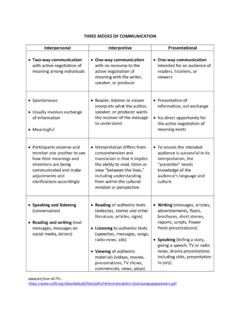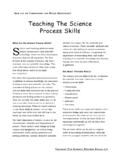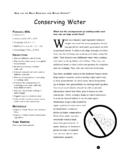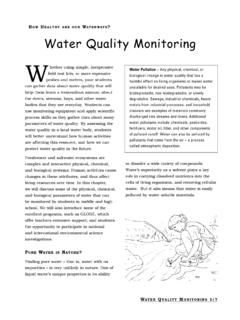Transcription of Teaching The Science Process Skills - Longwood University
1 HOW CAN WEUNDERSTAND OURWATERRESOURCES? Teaching The Science Process SkillsWhat Are the Science Process Skills ? Science and Teaching students about Science means more than scientificknowledge. There are three dimensionsof Science that are all important. The first of these is the content of Science , the basicconcepts, and our scientific knowledge. This is the dimension of Science that most peoplefirst think about, and it is certainly very other two important dimensions of sciencein addition to Science knowledge are processesof doing Science and scientific attitudes.
2 Theprocesses of doing Science are the scienceprocess Skills that scientists use in the processof doing Science . Since Science is about askingquestions and finding answers to questions,these are actually the same Skills that we alluse in our daily lives as we try to figure outeveryday questions. When we teach students to use these Skills in Science , we are alsoteaching them Skills that they will use in thefuture in every area of their third dimension of Science focuses on thecharacteristic attitudes and dispositions of Science .
3 These include such things as beingcurious and imaginative, as well as beingenthusiastic about asking questions and solving problems. Another desirable scientificattitude is a respect for the methods and values of Science . These scientific methods andvalues include seeking to answer questionsusing some kind of evidence, recognizing theimportance of rechecking data, and under-standing that scientific knowledge and theorieschange over time as more information is Science Process Skills form the foundationfor scientific methods.
4 There are six basic Science Process Skills : Observation Communication Classification Measurement Inference PredictionThese basic Skills are integrated together whenscientists design and carry out experiments or in everyday life when we all carry out fairtestexperiments. All the six basic Skills areimportant individually as well as when they are integrated six basic Skills can be put in a logicalorder of increasing sophistication, althougheven the youngest students will use all of theTEACHINGTHESCIENCEPROCESSSKILLS6/5 HOW CAN WEUNDERSTAND OURWATERRESOURCES?
5 Skills alongside one another at various the earliest grades students will spend alarger amount of time using Skills such asobservation and communication. As studentsget older they will start to spend more timeusing the Skills of inference and and measurement tend to beused across the grade levels more evenly, partly because there are different ways to doclassifying, in increasingly complex ways, andbecause methods and systems of measuringmust also be introduced to children graduallyover the basic Science Process skillstogether and gradually developing abilities todesign fair tests is increasingly emphasized insuccessive grade levels.
6 And is an expectationof students by fourth grade. The VirginiaStandard of Learning (SOL) for fourth-graders includes, for example, creatinghypotheses and identifying and manipulatingvariables in simple experiments. At this level,the students are beginning to really ask andanswer their own questions in a scientificsense. The following Designing an Experimentand Analyzing Experimental Datasections willfocus on using the integrated Science processskills to design experiments and reach the Virginia Standards of Learning, the firstscience SOL ( ) at every grade level K 12tells which of the Science Process Skills shouldbe introduced and emphasized at that gradelevel.
7 For grades K 6, where the SOL at eachgrade includes content from all areas of Science , organized in strands across thesegrade levels, the Science Process Skills SOLfalls in the Scientific Investigation, Reasoning,and Logic strand. For grades 7 12 (LifeScience, Physical Science , Earth Science ,Biology, Chemistry, then Physics) the SOL areno longer organized in vertical strands, but thefirst SOL at each of these grade levels stilldefines the Science Process Skills to be taughtand practiced at that grade level. For all gradelevels K 12, the intention is that the scienceprocess Skills be taught and practiced by students in the context of the content SOL for that grade level.
8 Students will work on different content areas of Science during theyear, and all year long they will continue to use and develop further the Science processskills for their grade is the fundamental Science processskill. We observe objects and events using all our five senses, and this is how we learnabout the world around us. The ability to make good observations is also essential to the development of the other Science processskills: communicating, classifying, measuring,inferring, and predicting. The simplest obser-vations, made using only the senses, are qualitative observations.
9 For example, the leafis light green in color or the leaf is waxy andsmooth. Observations that involve a number or quantity are quantitative observations. ForTEACHINGTHESCIENCEPROCESSSKILLS6/6 HOW CAN WEUNDERSTAND OURWATERRESOURCES?example, the mass of one leaf is five grams or the leaves are clustered in groups of observations give more preciseinformation than our senses surprisingly, students, especially youngerchildren, need help in order to make goodobservations. Good, productive observationsare detailed and accurate written or drawndescriptions, and students need to be promp-ted to produce these elaborate reason that observations must be so full ofdetail is that only then can students increasetheir understanding of the concepts being stud-ied.
10 Whether students are observing with theirfive senses or with instruments to aid them, we can guide them to make bettermore detailed descriptions. We can do this by listening to students initial observationsand then prompting them to elaborate. Forexample, if a student is describing what he orshe can see, they might describe the color of anobject but not its size or shape. A studentmight describe the volume of a sound but notits pitch or rhythm. We can prompt students toadd details to their descriptions no matterwhich of the five senses they are using.












